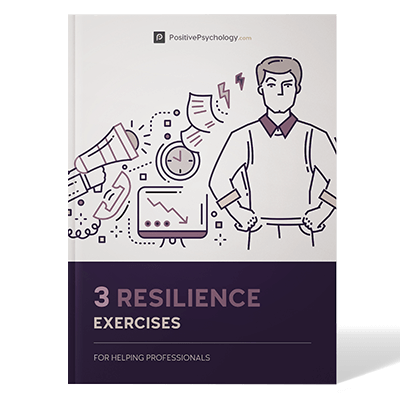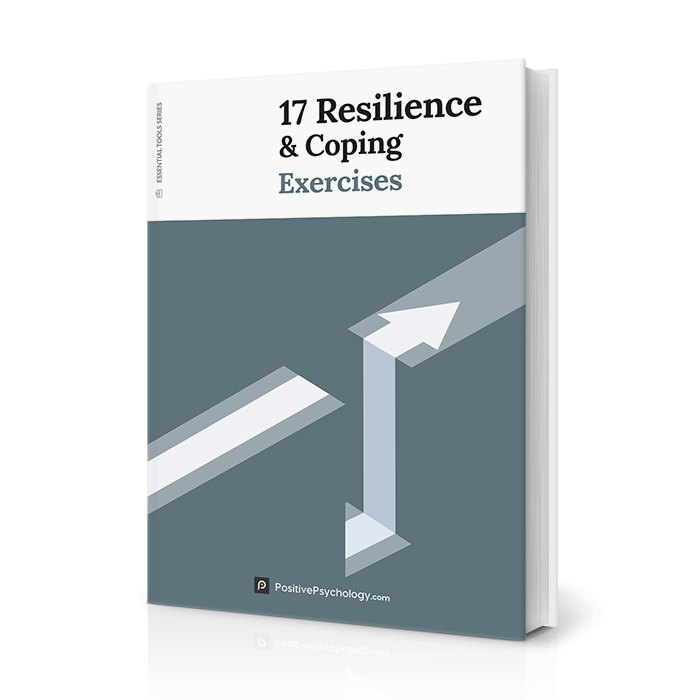23 Post Traumatic Growth Worksheets for Therapy (+PDF)

Post Traumatic Growth, or PTG, explains how trauma survivors can not only heal from their trauma, but can actually learn from the experience to become more resilient individuals.
In the mid-1990s, psychologists Richard Tedeschi and Lawrence Calhoun (Tedeschi & Calhoun, 1996) discovered that the severe psychological struggle that follows major life crises can result in positive growth and deepening resilience afterward.
While our other PTG article defines Post-Traumatic Growth with detail on the concept itself and the science behind it, this article provides you with practical tools to apply PTG with your clients or students.
Before you continue, we thought you might like to download our three Resilience Exercises for free. These engaging, science-based exercises will help you cope with difficult circumstances and give you the tools to improve the resilience of your clients, students, or employees.
This Article Contains:
A Look at Trauma Therapy Techniques
There are many trauma therapy techniques mentioned in this article. In this section, we will explore how some of these techniques can be applied to promote post-traumatic growth (PTG) using the model developed by Stephanie D. Nelson, a Behavioral Science Officer from the United States Army.
In 2011, Nelson developed a posttraumatic growth path (PTGP) for veterans suffering from post-traumatic stress disorder (PTSD; Nelson, 2011). This pathway can also work with other types of trauma survivors.
The program comprises four stages for those struggling with PTSD symptoms (Nelson, 2011):
- Deal,
- Feel,
- Heal, and
- Seal.
Evidence shows the techniques applied during each stage are beneficial for relieving specific PTSD symptoms in all types of trauma survivors and promoting post-traumatic growth (Ogilvie & Carson, 2021).
1. Deal – Writing a Trauma Narrative
This stage consists of writing a trauma narrative by focusing on the facts surrounding the incident(s), including the who, what, where, and when. Next, the client describes the thoughts and feelings that arose during the experience to create a comprehensive narrative.
Finally, the client is asked to write a paragraph reflecting on how they feel now, what they have learned, and if they have grown from the experience. Trauma survivors should complete this exercise with a therapist or counselor for support with any distressing feelings and sensations that may arise such as flashbacks, anxiety, or panic.
Once the trauma narrative is completed, the client proceeds to step 2.
2. Feel – Imaginal Exposure
The next step involves experiencing the feelings aroused by reading the trauma narrative aloud using imaginal exposure.
Exposure therapies work by exposing then desensitizing clients to any uncomfortable, distressing, and frightening feelings associated with the original trauma (Van Der Kolk, 2014).
Imaginal exposure entails revisiting the experience in the mind’s eye using the vivid sensory capacity of the imagination. Imaginary exposure to traumatic experiences using a trauma narrative, helps clients fully process their feelings with the support of a counselor or therapist.
This technique reconnects the client to their original emotional responses to the trauma which otherwise can become displaced onto other associated stimuli called ‘triggers’. Often, trauma survivors avoid emotional triggers which can lead to a narrowing of life experience and a lower quality of life.
For example, physical contact with their partner or spouse may trigger a rape survivor who withdraw or even freeze upon physical contact. This can destroy a survivor’s capacity for intimate relationships.
Imaginal exposure allows a client to process any repressed feelings safely, and overcome avoidance.
3. Heal – Channeling PTG
Stage three helps the client reintegrate their feelings and thoughts about the original trauma to facilitate opportunities for learning and growth. The healing stage involves three phases.
- Freedom of choice
During this phase, the therapist explains that while the client did not choose their traumatic experience, they can choose how to go forward. The narrative therapy technique of “rewriting the ending” can help the client create their own path. - Finding meaning
The client is encouraged to find meaning in their experience in whatever way is appropriate and workable for them. - The hero archetype
Finally, the therapist guides the client through the transformative journey of the Hero archetype by re-telling their story in the context of the client’s spiritual and cultural values to make the experience more meaningful. The client may also benefit from hearing stories where the hero experiences a significant trauma and becomes a much stronger person as a result.
Once these three techniques have been explored, the therapist can teach the client PTG channeling which involves redirecting their emotional energy away from avoiding triggers into productive, goal-oriented behavior. The therapist may assign the client homework exercises to help shift them from survival toward post-traumatic growth.
4. Seal – The mind as a filing cabinet
The last step of the post-traumatic growth path involves reorganizing the traumatic memory using the “mind as a filing cabinet” metaphor. This likens the memory of the traumatic experience to disorganized information scattered throughout the filing system of the mind.
Rather than the files being neatly ordered, numerous folders contain fragments of information that are confusing and disorientating.
The ‘sealing’ step reorganizes memories as files and stores them away safely. Files can be consulted in the future, but are no longer anything more than one of the many files that are stored in the cabinet of the mind.
The client may need to repeat this process of reorganizing further memories over the course of therapy.
For a moving true-life account of how traumatic childhood experiences can lead to post-traumatic growth and a rounded, fulfilling life, check out this TEDx talk by Martha Londagin below.
Post Traumatic Growth Worksheet
Here at PositivePsychology.com, we have several free worksheets that help clients deal with trauma.
However, we selected one as the ultimate post traumatic growth worksheet.
The worksheet start by identifying what is distressful, and causes avoidance.
Avoidance is a strategy trauma survivors often use to eliminate triggers and other associations with the original traumatic event. The problem with avoidance is that it constrains life by restricting options and prevents learning and growth.
The consequences of avoidance are an intensification of fear and restrictions that undermine quality of life.
It is possible to overcome avoidance through gradual exposure until desensitized to the triggering stimuli. Although this process is uncomfortable, it results in an increased sense of safety, widens options, and leads to a more fulfilling life (Collier, 2016).
The post-traumatic growth worksheet then assists with selecting and implementing healthier coping mechanisms than avoidance.
You can access the Conquering Avoidant Tendencies worksheet via the link.
6 PTSD Worksheets (PDF)

The worksheets include identifying triggers, self-regulating emotions, grounding, decatastrophizing, and taking steps towards gratitude for the things they still enjoy and that support them as they heal.
1. What are your unique triggers?
Identifying triggers is an essential coping skill that can help a client manage their symptoms during their recovery. If a client is aware of their triggers this also helps in overcoming avoidance (Van Der Kolk, 2014).
Look at our What Are Your Unique Triggers? worksheet for guidance.
2. Letter of self-compassion
Cultivating self-compassion is crucial when recovering from a traumatic experience (Collier, 2016). All too often we expect way too much of ourselves and don’t give ourselves enough time and space to heal. Try our Letter of Self-compassion worksheet and read it aloud whenever the inner critic looms.
3. Skills for self-regulating emotions
An ability to self-regulate our emotions is an essential life skill in any context but this can be especially challenging after a traumatic experience when our emotions can become unpredictable or even numb (Van Der Kolk, 2014).
Try our Skills for Self-Regulating Emotions worksheet to help clients self-soothe.
4. Catastrophizing and decatastrophizing
Catastrophizing entails imagining the worst-case scenario every time we face a problem. It is rooted in a limbic brain response designed to protect us from danger, but following trauma, it can be a symptom of hypervigilance (Van Der Kolk, 2014).
Try our Decatastrophizing worksheet for practical support.
5. Countdown to calmness
Grounding ourselves is essential when feeling disconnected from our body or environment, or after catastrophizing (Van Der Kolk, 2014).
Try our Countdown to Calmness worksheet which uses radical acceptance to ground you by focusing on your five senses.
6. It could be worse
Despair and anger are natural responses to a traumatic experience that can rob our lives of meaning (Collier, 2016).
Try our It Could be Worse worksheet to help your client take small steps toward gratitude for the little things that they can still appreciate while they heal, such as a nourishing meal, a walk in nature, or a chat with a relative or friend. This will help to dissolve despair and anger over time.
3 Common Therapy Techniques for Trauma
Although there are various therapies that can be used for trauma therapy, including EMDR, the following are commonly known therapy types used.
Narrative Therapy
Narrative therapy was developed in the 1980s by Michael White and David Epston (White & Epston, 1990). We explained above how writing a trauma narrative can be used to process and integrate traumatic experiences.
White and Epston believed that separating a person from their problematic behavior was crucial for therapeutic success (White, 2011). Narrative therapy achieves this by helping clients externalize their experience in writing.
White and Epston (1990) formulated their model using three key principles:
- Narrative therapy is respectful.
- Narrative therapy is non-judgmental.
- Narrative therapy views the client as the expert on their problems.
Narrative therapy equips clients with story-telling skills to help separate their sense of personal identity from their trauma. When the client stops seeing their trauma as an integral part of their identity, resolving to learn and grow from the experience becomes easier (Van Der Kolk, 2014).
Art Therapy
Art therapy is a therapeutic practice that uses visual arts techniques to facilitate the therapeutic process and can be especially helpful given that many aspects of traumatic experiences are difficult to express in words (Malchiodi, 2020).
A client doesn’t need any artistic skills to take part in this type of therapy. Rather, the art therapist encourages the client to tap into their creative process to explore and express emotions and develop greater self-awareness. This can help with processing buried conflicts and unresolved trauma.
For a more detailed account of this approach to trauma therapy, we recommend these art therapy, and expressive arts therapies articles.
Play Therapy
Play therapy is typically used to facilitate psychotherapy with children but can also be used with adults. Play therapy requires movement which can help address unresolved trauma that is difficult to express in words, especially for children (Allen & Hoskowitz, 2017).
Play therapy incorporates many techniques such as sand and water play, role play, and the use of representational toys like dolls, trucks, and guns to create play that expresses the client’s traumatic experience. This helps the client externalize their trauma similar to narrative therapy and art therapy, making the experience easier to process (Allen & Hoskowitz, 2017).
16 PDF Trauma Worksheets

We have grouped them into 5 themes for your convenience.
1. Strengths
Identifying a client’s strengths and previous experiences of overcoming difficulties helps with recovery from a traumatic experience. These two worksheets help clients identify their character strengths and recognize their capacity for post-traumatic growth.
2. Exposure
Exposure is an evidence-based approach to overcoming triggers and avoidance. These three worksheets can help guide clients through different types of exposure.
- For physiological symptoms of trauma try our Interoceptive Exposure worksheet,
- For traumatic memories try our Imagery Based Exposure worksheet
- For feared objects and situations try our Graded Exposure worksheet.
3. Anxiety
Fear and anxiety are common responses to trauma which can lead to dysfunctional thinking. These four worksheets are designed to help clients cope with the anxiety that often arises during and after trauma, and support them in moving on to post-traumatic growth.
- Challenging Catastrophic Thinking Worksheet
- Replacing ‘What if’ Statements
- Dysfunctional Thought Record
- FLARE for Anxiety and Fear
4. Grounding
Feeling far away or unreal is common following a traumatic experience. This is because of the dissociation and depersonalization that can occur as the body struggles to process sensory overload.
These three worksheets are designed to ground clients in the present moment using breathwork and radical acceptance.
5. Growth
Finally, these four worksheets have been designed using evidence-based interventions that promote post-traumatic growth.
Eye Movement Desensitization and Reprocessing (EMDR) involves coupling negative cognition with a chosen target image, selecting a positive replacement cognition, then reprocessing traumatic memories into more adaptive thoughts.
Download our EMDR Worksheet to find out more.
Meanwhile, our Imaginal Exposure worksheet uses the Subjective Units of Distress Scale (SUDS) to quantify the disturbance a client feels when revisiting their traumatic experience during therapy. It is especially useful for those who misuse substances to self-soothe.
Your clients can also try this Goal Planning and Achievement Tracker worksheet to monitor their progress during their post-traumatic growth journey.
Finally, our Growing Stronger From Trauma worksheet helps clients identify what they’ve learned from a traumatic experience, and appreciate the strengths they have developed as a result. This exercise helps clients cultivate a more balanced perspective on previous trauma and identify ways to manage future challenges.
Activities for Trauma Therapy
The following activities aim at improving the reintegration of the mind, heart, and body connection that is often fragmented by a traumatic experience.
1. Psychoeducation
Psychoeducation is an important intervention to help trauma survivors understand they are experiencing a normal response to an abnormal experience. (Whitworth, 2016).
Our article on psychoeducation interventions explains more.
2. Self-soothing
Equipping a client with self-soothing skills will help support their recovery between sessions (Dreisoerner et al., 2021).
Look at our article 24 Best Self-Soothing Techniques and Strategies for Adults for more resources.
3. Expressive arts
Expressive arts activities can help to process blocked emotional responses to trauma through painting, drawing, clay modeling, photography, music, and movement (Malchiodi, 2020).
Check out our article Expressive Arts Therapy: 15 Creative Activities and Techniques for more resources.
4. Mindfulness
Mindful movement can support grounding when clients feel scattered or fragmented (Teut et al., 2013). Take a look at our articles on Mindful Yoga and Mindful Walking for further guidance.
5. Nature therapy
Ecotherapy interventions are deeply grounding for trauma survivors (Atkins & Snyder, 2017). Activities include forest bathing (Mao et al., 2012), walking in nature, or just gazing at the ocean (Cracknell, 2019).
Check out our article on the Positive Effects of Nature for activity ideas.
PositivePsychology.com Resources
Besides all the resources we’ve included above, consider our 6-module, science-based Realizing Resilience Masterclass©. It includes all the resources you’ll need to deliver high-quality resilience training and more.
We have other useful related articles with linked resources including:
- 7+ Trauma-Focused Cognitive-Behavioral Therapy Worksheets. Trauma-focused CBT comes highly recommended by the APA as a trauma treatment with a firm evidence base.
- What is Post-Traumatic Growth? (+ Inventory & Scale) examines the science behind PGT in detail.
- PTSD Treatment: How to Support Clients Dealing With Trauma includes psychoeducation tips and resources for working with children and groups.
- Military Counseling & Helping Veterans Deal With Trauma offers more specialized guidance on working with this client group after they have served in an active combat zone.
If you’re looking for more science-based ways to help others overcome adversity, this collection contains 17 Resilience & Coping Exercises. Use them to help others recover from personal challenges and turn setbacks into opportunities for growth.
A Take-Home Message
We hope you find the resources in this article useful. Nobody wants to suffer, but we will inevitably face adverse experiences, whether it’s through loss and grief, sudden illness or injury, a natural calamity, or witnessing violence and extreme suffering in others.
If you struggle with trauma and its aftermath, remember that you have overcome obstacles in the past, and that you can draw on those experiences to cultivate the skills you need to process your experience, and become a wiser, more compassionate, and more resilient person as a result.
Finally, if you would like further inspiration about the potential for growth after trauma check out this short and powerful TED Talk by trauma survivor Charles Hunt. You won’t regret it!
We hope you enjoyed reading this article. Don’t forget to download our three Resilience Exercises for free.
- Allen, B. & Hoskowitz, N. A. (2017). Structured trauma-focused CBT and unstructured play/experiential techniques in the treatment of sexually abused children: A field study with practicing clinicians. Child Maltreatment 22(2), 112-120.
- Atkins, S., & Snyder, M. (2017). Nature-based expressive arts therapy: Integrating the expressive arts and ecotherapy. Jessica Kingsley Publishers.
- Collier, L. (2016). Growth after trauma. Monitor on Psychology, 47(10).
- Cracknell, D. (2019). By the sea: The therapeutic benefits of being in, on, and by the water. Aster.
- Dreisoerner, A., Junker, N. M., Schlotz, W., Heimrich, J., Bloemeke, S., Ditzen, B., & van Dick, R. (2021). Self-soothing touch and being hugged reduce cortisol responses to stress: A randomized controlled trial on stress, physical touch, and social identity. Comprehensive Psychoneuroendocrinology, 8.
- Malchiodi, C. A. (2020). Trauma and expressive arts therapy: Brain, body, and imagination in the healing process. Guilford Press.
- Mao, G. X., Lan, X. G., Cao, Y. B., Chen, Z. M., He, Z. H., Lv, Y. D., Wang, Y. Z., Hu, X. L., Wang, G. F., & Yan, J. (2012). Effects of short-term forest bathing on human health in a broad-leaved evergreen forest in Zhejiang Province, China. Biomedical Environmental Science. 25(3), 317-24.
- Nelson, S. D. (2011). The posttraumatic growth path: An emerging model for prevention and treatment of trauma-related behavioral health conditions. Journal of Psychotherapy Integration 21, 1-42.
- Ogilvie, L. & Carson, J. (2021) Trauma, stages of change and post-traumatic growth in addiction: A new synthesis. Journal of Substance Use, 27 (2), 122-127.
- Tedeschi, R. G. & Calhoun L. G. (1996). The Posttraumatic Growth Inventory: measuring the positive legacy of trauma. Journal of Traumatic Stress. 9(3), 455-71.
- Teut, M., Roesner, E. J., Ortiz, M., Reese, F., Binting, S., Roll, S., … Brinkhaus, B. (2013). Mindful walking in psychologically distressed individuals: A randomized controlled trial. Evidence-Based Complementary and Alternative Medicine, 1–7.
- Van Der Kolk, B. (2014). The body keeps the score. Penguin.
- Whitworth, J. D. (2016). The role of psychoeducation in trauma recovery: Recommendations for content and delivery. Journal of Evidence-Informed Social Work, 13(5), 442-51.
- White, M. & Epston, D. (1990). Narrative means to therapeutic ends. W. W. Norton & Company.
- White, M. (2011). Narrative practice: Continuing the conversations (D. Denborough, Ed.), W.W. Norton.
Let us know your thoughts
Read other articles by their category
- Body & Brain (50)
- Coaching & Application (57)
- Compassion (26)
- Counseling (51)
- Emotional Intelligence (24)
- Gratitude (18)
- Grief & Bereavement (21)
- Happiness & SWB (40)
- Meaning & Values (26)
- Meditation (20)
- Mindfulness (45)
- Motivation & Goals (45)
- Optimism & Mindset (34)
- Positive CBT (29)
- Positive Communication (20)
- Positive Education (47)
- Positive Emotions (33)
- Positive Leadership (18)
- Positive Parenting (4)
- Positive Psychology (33)
- Positive Workplace (37)
- Productivity (17)
- Relationships (46)
- Resilience & Coping (38)
- Self Awareness (21)
- Self Esteem (38)
- Strengths & Virtues (32)
- Stress & Burnout Prevention (34)
- Theory & Books (46)
- Therapy Exercises (37)
- Types of Therapy (64)






What our readers think
A parent of a Marine that just had a tragic experience, and as a father would like to help in his recovery from PTSD from war ….
I’m a solution-focused narrative therapy and your PTG approach so resonates with me. Appreciate your work and resources and worksheets.
Thank you for the information!
Great information!
Great article. Interesting worksheets. Is there any link to these worksheets to download in pdf. Also looking for the ACTUAL PTG-24 tool link.
Hi Eulinda,
Glad you liked the article! If you click the hyperlinks in-text where the worksheet name is mentioned, they’ll take you to the PDF download. Also, I’m not finding a tool with this name in our Toolkit. Could you elaborate on what specifically the tool is about and perhaps I can help find what you’re looking for.
– Nicole | Community Manager
Thanks to share this wonderful articles.